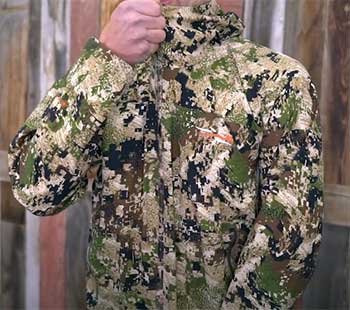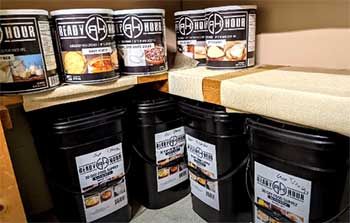If you’re an outdoor enthusiast, you’re probably no stranger to the endless debate of Sitka Dew Point vs. Thunderhead jacket. Both are renowned in their own right, but how do they stand up against each other?
In this article, we’ll dissect each jacket’s strengths and weaknesses, giving you a definitive guide to choose between the Sitka Dew Point and Thunderhead jackets.
A Brief Comparison Table
let’s take a look at a quick comparison table for a more visual overview of the differences between these two jackets:
| Features | Sitka Dew Point | Thunderhead |
| Weight & Packability | Lightweight and Highly Packable | Heavier and Less Packable |
| Wet Weather Performance | Excellent | Superior |
| Insulation | Less Insulating | More Insulating |
| Noise Factor | Normal | Very Quiet |
| Price | High | High |
Sitka Dew Point Jacket: Lightweight and Robust
The Sitka Dew Point jacket has become synonymous with lightness and durability. Weighing a mere 20.96 ounces, this jacket won’t slow you down on your outdoor adventures.
- Pros of the Sitka Dew Point Jacket

One of the biggest advantages of the Sitka Dew Point jacket is its GORE-TEX® technology.
This remarkable feature guarantees the jacket to be fully waterproof and windproof while still providing excellent breathability.
Lightweight and packable, this jacket is a backpacker’s dream.
Its small pack size won’t take up much space, leaving more room for other essentials.
- Cons of the Sitka Dew Point Jacket
Despite its many advantages, the Sitka Dew Point jacket isn’t without its faults.
One issue some users have reported is that it lacks insulation. So, while it’s perfect for blocking wind and rain, it might not be the best choice for colder weather.
Moreover, compared to other jackets in its class, the price point is quite high. However, the quality and durability can justify this higher cost for many.
Also Read: Differences Between KUIU Chugach And Yukon Jackets.
Thunderhead Jacket: The Ultimate Wet Weather Ally
The Thunderhead jacket is a formidable competitor in the world of outdoor gear. Its unique selling point is its superior performance in wet conditions.
- Pros of the Thunderhead Jacket
The Thunderhead jacket shines in its specialized wet weather design. Its waterproof GORE-TEX® fabric ensures you stay dry even in the most torrential downpours.
Comfort is another key factor here. The Thunderhead jacket has a brushed polyester knit face that keeps it soft and noiseless, enhancing comfort and reducing the chances of scaring off game while hunting.
- Cons of the Thunderhead Jacket
The Thunderhead jacket’s prime focus on wet weather can be a double-edged sword. While it excels in this area, it might not be as versatile as other jackets for less wet weather.
Additionally, like the Sitka Dew Point, the price can be a barrier for some. The Thunderhead jacket is also a premium product and comes with a premium price tag.
Key Differences Between Sitka Dew Point and Thunderhead Jackets
While both jackets impress with their unique features, there are several key differences that may influence your choice between the Sitka Dew Point and Thunderhead jackets.
- Weight and Packability

First up, let’s talk about weight and packability.
The Sitka Dew Point is the undisputed winner in this department.
Weighing in at just under 21 ounces, it is significantly lighter than the Thunderhead.
Furthermore, the Dew Point can be packed down to a small size, making it an excellent option for backpacking or traveling light.
- Wet Weather Performance
When it comes to wet weather performance, the Thunderhead has the upper hand.
While both jackets use GORE-TEX® technology for water resistance, the Thunderhead’s design focuses specifically on excelling in rainy conditions.
If you’re frequently outdoors in heavy rains, the Thunderhead may be the better option.
- Insulation
Insulation is another area where these two jackets differ. Neither jacket is designed to be a heavy-duty cold weather coat, but there are differences in their thermal efficiency.
The Dew Point, given its lighter weight and thinner fabric, does not provide much insulation and is more suited for mild to cool weather.
On the other hand, the Thunderhead, while not heavily insulated, does offer a bit more warmth due to its slightly thicker material. However, remember that both jackets are designed with layering in mind – you’re meant to pair them with appropriate base and mid-layers depending on the weather.
- Noise Factor
Finally, the noise factor is worth mentioning. The Thunderhead jacket comes out on top here, boasting a soft, brushed polyester knit face that minimizes noise during movement.
This can be crucial if you’re hunting and don’t want to scare off game. The Dew Point, while not excessively noisy, doesn’t have the same focus on noise reduction.
Also Read: Comparison of Sitka And Nomad Jackets.
Final Thoughts
Both the Sitka Dew Point and Thunderhead jackets have their unique strengths and weaknesses. While the Dew Point jacket impresses with its lightweight and robust nature, the Thunderhead jacket stands out for its superior wet weather performance.
If you’re a backpacker who values weight and packability, the Sitka Dew Point jacket might be your best bet. However, if you’re often facing heavy rains, the Thunderhead jacket will prove to be an indispensable ally.
Remember, the best jacket for you is not about the highest price or the flashiest features. It’s about what serves your needs best. So, are you Team Sitka Dew Point or Team Thunderhead?
And there you have it, a comprehensive review of the Sitka Dew Point and Thunderhead jackets. Armed with this knowledge, you’re now ready to make an informed decision and find the perfect jacket for your outdoor adventures.
Happy trails!

